ChatGPT & AI in
Procurement Course
Free Preview Lesson

Written by Marijn Overvest | Reviewed by Sjoerd Goedhart | Fact Checked by Ruud Emonds | Our editorial policy
Negotiation Statistics 2024 — 20 Key Figures
Key takeaways
- Businesses are training sales teams to utilize transparent policies and data-driven benchmarks for their benefit.
- Negotiators are adopting more personal strategies, aiming to discover common ground with buyers.
- Successful negotiators are integrating concessions strategically into their offers, recognizing that inflexibility can harm the brand image and customer relations.
Negotiation is part of our everyday life even if we do not notice it. In a professional setting, negotiation is a crucial part of the growth of your business. However, how does the negotiation look nowadays?
In this article, we will show you some figures about negotiation in businesses. Additionally, we will check some of the factors that affect negotiation nowadays.
Once you are done reading this article, you will know the latest things you should know in negotiation for you to be able to negotiate well, especially this 2023. So without further ado, let us now start!
Negotiation Statistics in 2024 That You Should Know
Here are some Negotiation statistics for 2024 you may want to know!
1. Greater Negotiation Counteroffer Deems Higher Adjustment of the Third Offer
In contract negotiations, the first offer plays a crucial role since it anchors the negotiators’ perceptions and influences the negotiation outcomes. However, a recent study entitled Beyond the First Offer: Decoding Negotiation Openings and Their Impact on Economic and Subjective Outcomes found that counteroffers against the first offer have an impact on the following negotiation behaviors.
The more extreme a counteroffer is, the higher the adjustment of the third offer especially with the suppliers adjusting their prices down. However, this behavior also emits a reduced satisfaction and impression rate of suppliers for procurement experts. In addition to that, it also weakens supplier relationships.
2. Vanderbilt Business Reveals that Women Negotiate for Their Salaries More Often than Men Do
According to the Vanderbilt Business Review, women negotiate for higher pay as a way to close the gender wage gap. With the presence of gender discrimination, however, their negotiations often get rejected.
Although previous studies show that women ask less often, in a more recent study in the first quarter of 2023 conducted by Kennedy, Kray, and Lee, it was revealed that the general idea of only 47% of women workers vs 64% of men who negotiate is a myth. Rather, in their study, they compiled other broader studies and compared different data sets to come up with the result that 54% of women reported negotiating offers compared to 44% of men.

3. Companies Lacking Formal Negotiation Processes Show a 63.3% Decrease in Net Income
In a study presented by Huthwaite International, 80% of companies around the globe do not have negotiation processes and it prevents them from earning more.
Researchers explained that during negotiation processes, product prices are adjusted, deals are offered, and more favorable terms are introduced. Thus, by making use of them, organizations may arrive at a position where they can save a lot of money and get the best quality of products and services at their best value. However, in the absence of a negotiation process, companies may lose those advantages, and ultimately lose a great value of finance.

4. 66% of Workers in the US Found Salary Negotiations Successful to Raise Their Pay
Salary negotiations are becoming a notable tactic for workers to raise their offered pay before they start working. It is also one way to assess oneself and evaluate skills and experience in a certain field should they feel the pay cannot compensate.
So, in a broader survey conducted by Pew in early 2023, it was found that 66% of job candidates got better starting salary offers after negotiating for more.

5. Virtual Negotiations in 2023 Can Lead to Misunderstanding and Unclear Message of Intention
As the business industry adapts to the world’s fluidity, business negotiation processes also become more flexible and open to virtual platforms like phone calls, emails, Zoom, and the like.
However, a recent study conducted by Graham Brown of the University of British Columbia and Markus Baer of Washington University in St. Louis found that meeting face-to-face to negotiate is more likely to end up with clearer agreed-upon terms, parties giving the notion of commitment, and overall favorable advantages.
6. A recent 2023 Fidelity Study Showed that 58% of Working Americans Accepted Job Offers Without Negotiating for More
Negotiating for more pay during the offer stage of the job hiring process may feel uncomfortable and unethical, but in reality, it is not. Employers expect candidates to negotiate their starting salaries. Moreover, doing so can significantly impact and increase your lifelong earning potential if done correctly and consistently.
However, although employers may expect potential employees to ask for more, 58% of working Americans accept job offers without initiating any negotiation process.
7. Inflation Can Negatively Impact Negotiation Strategies Because Inflation Rate Spikes to 4.7% in 2023
Although the inflation rate this year is relatively lower compared to 2020’s 6.22%, it is still higher than expected. With that, prices increase but what’s concerning is that the unemployment rate also increases when it should counter the status of the inflation rate. In addition, China’s construction industry is predicted to shrink by 7% by the end of 2023.
Thus, negotiations for better prices of goods and services may be impacted to present themselves as a challenge for many companies.
8. Three Quarters in 2023, 73% of Employers Expect Job Candidates to Negotiate Salaries
According to CareerBuilder, up to date, employers expect potential employees to ask for more pay when they offer them job roles and positions. However, 55% of workers stay clear away from negotiating job offers.
One professor at Columbia Law School specializing in negotiations also echoed that workers should always be aware that they can and should negotiate every job offer they may encounter.

9. Annual Salary Raise Can Reach Up to More than 3% as opposed to Standards
Many studies reveal that a worker should be able to receive a 3% salary raise per year and not more than that. However, this 2023, Indeed has published newsletters and posts indicating that they can receive up to a 20% salary increase.
Furthermore, because there is no standard limit (unless covered by company policy) to how much one’s salary can be raised per annum, negotiation strategies can come in handy for workers deeming themselves worthy of a higher raise.
However, the salary raise is still debatable because companies are not required to grant that to all workers. Should they be undeserving of the said raise, then the opportunity can be passed on to another.
10. The Negotiation Training Service Market Size to Reach a Multi-Million Dollar Value by 2029
Various studies claim that the negotiation training service market size will rise at a rapid rate between 2023 and 2030. It can be noted that the US, Europe, Asia, and the Pacific’s economic nature will greatly impact this prediction. Specifically, should North America or the US predict economic status, the global negotiation market’s forecasted value for the following years also change.
To dig deeper into this, the market size is expected to increase because of the rise of start-ups and businesses all across the globe. So, as part of every business operation, in the procurement process, negotiations play a crucial role. Thus, there will be a lot of negotiation training programs needed to perform successful business operations.
11. Negotiating Works with 84% of Workers Enjoying Higher Pay
According to Jobvite, negotiating works with a total of 84% successfully negotiating for higher pay. Thus, they get to enjoy at least 5% more of what they’re supposed to be starting with.
Moreover, out of those 84%, a fifth of them get 11-20% higher if, for example, you start with $3000 a month, you would get up to $4200 a month which would equate to $50, 400 a year compared to the base salary of $36, 000 with almost $15, 000 a difference.
12. Every Dollar Saved in Supplier Negotiations Go Straight to the Company’s Bottom Line
A report from the Red Bear Negotiation presents statistics that most of a company’s revenue still goes back to its suppliers because of repurchases of goods and services to continue business operations. So, even just a percent of the decrease in supplier expenses can increase profits up to 4%.
That is where the importance of supplier negotiations comes in. Naturally, a successful renegotiation of terms and deals can help companies save costs in procurement and the saved money can be utilized in other resources or departments within the company. Therefore, allocation of funds cannot be a challenge, and enforcement of great relationships with suppliers can be assured.
13. A Recent Study about Managing Key Supplier Relationships Names Negotiation as One of the Best Business Practices
Proponents of a 2023 Vantage Partners study about managing supplier relationships and the best practices to do it found that conducting proper negotiations is one of the most influential tactics to drive business operations to success.
Out of 100 companies they surveyed, leading organizations like Amazon practice a thorough negotiation process to create value for themselves and their relationships with their suppliers. Other than that, great negotiations foster substantial agreements between all parties involved.
14. Almost ¾ of 124 Companies Listed in Forbes Global 2000 Do Not Use Negotiation Tools as of 2023
A study based on IACCM and Huthwaite discovered that out of 124 companies included in the world’s largest companies, 73% do not use any negotiation tools and software to help them with negotiating strategies.
The IACCM/Huthwaite study included a sample negotiation planner that was based on templates provided by several of the participating companies and most of them admitted that they rarely use the plans to commence negotiations with suppliers.
Even in 2023, some companies still do not see the importance of negotiations in cost-saving and supplier relationship management.
15. Use of BATNA Proven a Success in Gaining Negotiation Advantages in 2023
A Harvard professor and the author of Negotiation in 3D, James Sevenius, revealed that negotiation plans and tactics are not enough to gain favorable deals when doing contract and value negotiations.
He deemed that the Best Alternative to a Negotiated Agreement or BATNA helps companies determine the best alternatives in negotiations which simply means having back-up negotiating plans never fails.
Moreover, ensuring an exit strategy is a good negotiation strategy because it gives companies the upper hand in the whole agreement ordeal.
16. A recent 2023 Study by Orr and Guthrie Shows How Anchoring in Negotiations Can Negatively Impact the Negotiation Process
According to a Harvard Law Review, anchoring refers to the tendency to put an unnecessary numeric value so that other parties can adjust or counter the first offer. The anchoring bias is often used in bidding and negotiation strategies.
However, if a company initiates the anchoring bias, it may be bad since its suppliers can back out from the dealing due to incompetence to see their products’ value. Thus, Orr and Guthrie suggested not relying on numbers when negotiating.
17. Cooperative or Problem-Solver Negotiators are More Likely to Succeed in Negotiation Tactics in 2023
There are 2 main negotiation styles: Competitive or Cooperative. The former uses a more proactive and aggressive approach as negotiators using this style have the control or the upper hand in the process. Meanwhile, those who are more cooperative take into account the importance of other parties involved.
Negotiations revealed that 59% of successful negotiators use a cooperative approach while only 9% of successful negotiators use an adversarial type. Thus, in 2023 and for the succeeding years to follow, using a gentler approach to negotiate can be more advantageous than asserting dominance.
18. Virtual Negotiations have been Proven to be Slower with an Average Time of 43 Minutes than Physical Negotiations with an Average Time of only 16.4 Minutes
In the study published by Emerald, 68 individuals were tasked to act in negotiation scenarios physically and virtually. During face-to-face negotiation processes, participants went to perform a role-play exercise for the negotiation process and achieved great results.
On the other hand, for the virtual negotiation practice, the participants used Zoom as the online platform where they could conduct the experimental study. The average time for all 68 students to finish their negotiations reached more than 43 minutes.

19. Negotiations to Deliver a Set of 4 Biodiversity Goals to be Achieved by 2050
The UN’s agenda for sustainable development and other global environmental frameworks underlined the importance of negotiations, especially in delivering global economic sustainability. This initiative is still ongoing and is scheduled to wrap up in 2024 for the threat to curb plastic pollution to be adopted in mid-2025. Should this be a success, biodiversity goals, environmental development, and overall global improvement will be achieved by 2050.
20. Poll Reveals that Poor Negotiation Skills Drive a 5% Profit Loss
Imparta’s webinar, Sales Negotiation: How to Win in 2023, addressed the challenges triggered by inflation and covered crucial topics like types of negotiators, understanding procurement, creating more value, and discovering powerful procurement tactics. In addition, a survey was conducted and the participants acknowledged that poor negotiation skills led to a loss of more than 5% in profits and highlighted the potential for a 50% profit improvement through enhanced negotiation skills. Thus, businesses need to adopt better negotiation strategies with suppliers, especially with contracts to drive more profit and ROIs.
Sales Negotiators’ Heavy Reliance on Data
Nowadays, it is possible to sell more while negotiating less when negotiators rely on data to speak for their results.
Many companies are continuously training their sales team to use transparent policies which lay bare their operations and quantify their results.
According to IBM, data-driven benchmarks and substantiated numbers are realizing desired outcomes.
You can see it happening already as many people are now starting to do their own research before they try to purchase. People are more likely to buy from businesses that show quantified results with supported data-driven benchmarks.
Aside from this, many negotiators are leveraging intelligent data before chasing leads. This is due to the fact that when you collect data on your existing leads and use it as your benchmark before chasing new leads, then you are going to get more success.
A Personalized Approach to Negotiation
More and more negotiators are working on using more personal strategies to win over clients. The goal here is to discover if you have a common idea that you share with your buyer and then leverage that common standpoint while dealing with them.
Additionally, upcoming trends are suggesting that buyers have a special affinity for personalized approaches. According to a study, 90% of consumers found personalization appealing and 80% of customers said that they are more likely to do business with a company that has personalized approaches.
When buyers find that you have similar shared values, they are more likely to work and accept your terms in the negotiation.
Leveraging In-Built Concessions
No one wants to lose in a negotiation. Both parties always want to receive something in exchange in the negotiation. Thus, taking an inflexible stance without concessions changes their perception of you negatively which can ultimately affect your brand image and customer relations.
Nowadays, it is common for many negotiators to create initial offers with pre-planned concessions. Thus, having a negotiation strategy and BATNA with built-in concessions helps give the other party the feeling that they have won something.
Once you get the other party to say “yes” to a few concessions in your favor, then it will be easier for you to reach the big “YES” to the whole deal.
Now that we have listed the things that will affect negotiation in 2023, we will now go to negotiation statistics for 2023.
Conclusion
The landscape of negotiation in businesses is evolving, influenced by various factors and trends. This article sheds light on the current state of negotiation, emphasizing the importance of data, personalized approaches, and strategic concessions.
As businesses adapt to the changing dynamics, understanding key statistics and emerging patterns becomes crucial for successful negotiations.
Resources:
Frequentlyasked questions
What are negotiation statistics?
Negotiation statistics lets you show the newest trends in negotiation.
What is negotiation?
It is an approach between parties in a dispute seeking to reach a concession by finding a solution for both parties to agree with.
What is the importance of negotiation?
Negotiation is important as it holds the key to getting ahead in resolving conflicts and creating value in contracts.
About the author
My name is Marijn Overvest, I’m the founder of Procurement Tactics. I have a deep passion for procurement, and I’ve upskilled over 200 procurement teams from all over the world. When I’m not working, I love running and cycling.


